News from Borneo: Vol. 2
In the Malaysian state of Sabah of the island of Borneo, where the activities of the ITOCHU Group Forest for Orang-utans take place, eleven Company employees and employees of Group companies participated in a tree-planting tour.
We introduce here the fascinating natural environment the participants encountered and their thoughts about the tour.
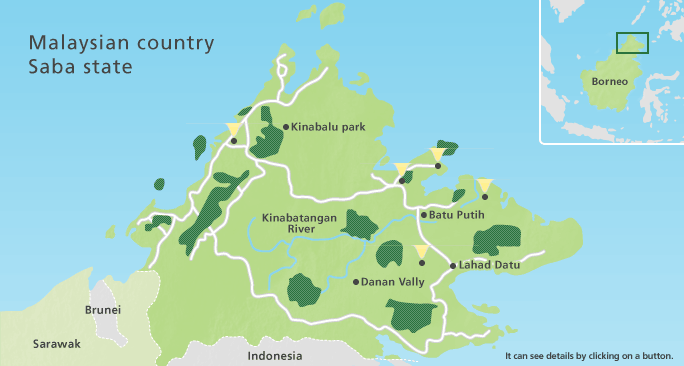
North Ulu Segama
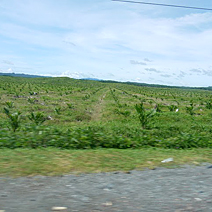
This is the reforestation area for this project. We are supporting 967 hectares (207 times the size of the Tokyo Dome) for forest regeneration. By the beginning of November 2010, approximately 160 hectares of forest had been planted.
Comments from Participants
Whether from the boat, the car or the plane, the palm tree plantations we saw seemed to stretch on forever. I was also struck by the harsh reality of man’s destructive power in seeing how people have tried to create a new world by chopping down the jungle where so many forms of wild life lived in balance.
The tragic landscape isn't on some distant planet, but stretches as far as the eye can see right under the same sky as ours, in a country with an hour time difference from Japan. This is something we must be careful never to forget.
Sukau
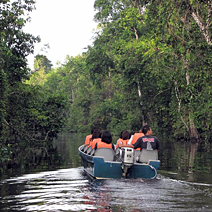
This is a popular location for cruises on the Kinabatangan River, and a place where you can come across many wild animals such as crocodiles and proboscis monkeys.
Comments from Participants
The cruise took on a different appearance at night than in the morning, and made me feel like I really was in the middle of the jungle. At night, we happened upon rarely seen slow loris and colorful kingfishers in the trees. As the boat proceeded along the river, we could see the red eyes of crocodiles reflect in the light on the surface of the water! In the morning, we encountered proboscis monkeys having breakfast. It was a great location for learning how humans and animals live side by side.
Sandakan
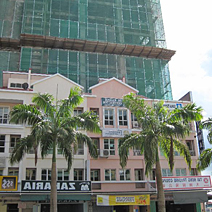
Sandakan is the second city after Kota Kinabalu. It flourished as trading post and as the heart of British North Borneo until 1947 when the capital was moved to Kota Kinabalu.
Comments from Participants
I heard that Sandakan was the second largest city in the province of Sabah, but I was surprised at how small it was and the densely packed old houses. New buildings were being constructed on the shabby remnants of the colonial era. I felt mixed emotions. On the one hand, I hope that an attractive cityscape befitting a tourist destination is created. At the same time, I also wish the genial locals can continue to live as they have until now.
Sepilok
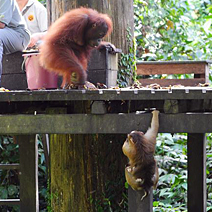
The Orang-utan Rehabilitation Centre, which returns orang-utans on the verge of extinction to the wild, is located here.
Comments from Participants
The sight of orangutans chasing away monkeys that were trying to pinch the food given to them by their keepers was human-like. I now understand why they say that the genetic makeup of orangutans is 96% the same as humans. While witnessing this spectacle, it reaffirmed for me the importance of forestation so that the number of protected orangutans doesn’t increase. After all, this place was a facility for protecting orangutans that had lost their parents due to forest development and other reasons.
Kota Kinabalu
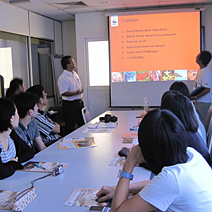
The gateway to tours of Borneo, Kota Kinabalu the city is also a growing commercial center with a population of approximately 300,000. WWF-Malaysia also has an office here.
Comments from Participants
The day before we began tree-planting activities, at the WWF office we heard about plans to create a Green Corridor stretching some 700 km that would connect the fragmented forests. While the trees we planted on this tour would account for only a fraction of the distance of this corridor, we felt that we had been entrusted with a major role since this was an important area right in the middle of the corridor.
Tree-Planting Tour
Itinerary
Video of the tour
Reforestation Status as of November 2010
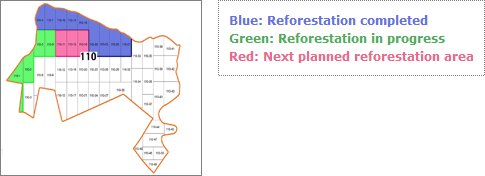
As of early November 2010, 163 hectares of forest had been planted (blue portion). At present, approximately 80 hectares is being reforested (green portion), and the aim is to have completed planting 300 hectares by the end of 2010. Work was interrupted between February and May 2010 by a local drought, but is now proceeding steadily. This tour planted trees in the 110-5 block in the upper left part of the map.
Tree-planting Report
We took the red-eye from Kota Kinabalu to Lahad Datu, where we left the plane and traveled to the tree-planting site in four 4WD vehicles.
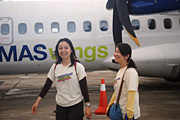
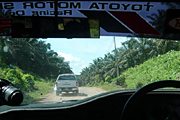

The day before, we learned a lot about methods and the importance of forest protection as well as orangutan survey methods at the WWF-Malaysia office, which filled everyone with expectation and enthusiasm.
Handy Information 1
The area surrounding the ITOCHU forest has a relatively higher concentration of Borneo orangutans than other areas. In this area, the lives of 14 orangutans are studied by 5 researchers. The WWF has given names to currently identified orangutans and continues to conduct surveys. A helicopter is also used to conduct ongoing surveys from the air.
Under clear skies that belied the rainy season, palm tree plantations spread out before our eyes as we left the town from the airport. All we could see was palm trees of varying sizes that went on and on.
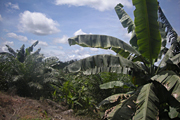
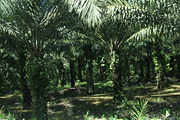
Here and there, palm trees were immersed in water, and we learned later that just before our visit, heavy rains had flooded some villages.
All of a sudden the palm trees ended, and we had arrived at our destination, the protected area managed by the WWF.
This area was definitely different from the jungle image that I had painted in my mind. There were pockets of tall trees here and there under the wide blue sky.
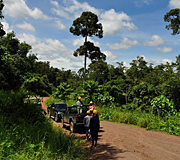
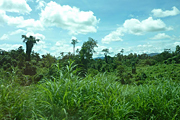
After arriving, we assembled for a group photograph shoot first with local workers before we got sweaty and muddy.
There were lots of girls, so it was a cheerful atmosphere. The workers seemed to be happy as well. Later, we planted a commemorative tree in front of the board.
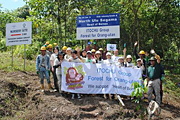
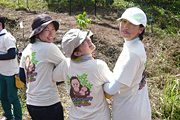
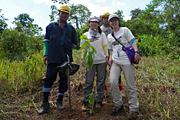
After the photo shoot, we went to inspect the growth of the trees that had been planted in the past while getting bitten by various insects along the way. We saw a small stream in the middle of the jungle inhabited by shellfish and fish.
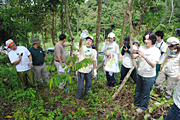
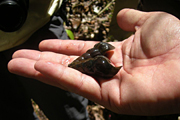
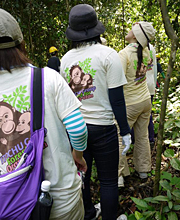
Growth Status of Planted Trees
Pioneer tree variety
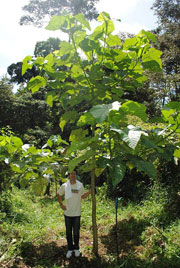
Dipterocarpaceae
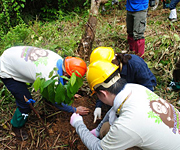

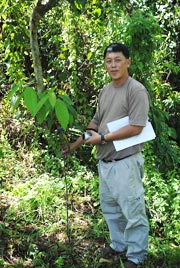
The photograph on the left shows trees that were planted in February 2010. The trees had grown quite tall in just nine months. A type of tree indigenous to Malaysia with a particularly high growth rate had been planted. These trees are now around six meters high.
Handy Information 2
The Pioneer tree variety grows quickly, creating shade. In the shade of these trees, Dipterocarpaceae trees, a commonly found local variety of tree, grow slowly, eventually reaching a height of 70 to 80 meters. The fruit and leaves of Pioneer trees are eaten by wild animals.
After eating lunch and drinking coconut juice, we finally headed off to plant trees. We entered the jungle under the blazing sun.
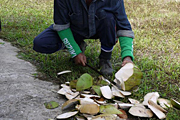
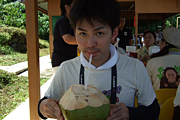
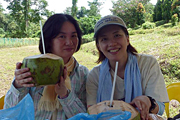
Under the guidance of the workers who were paired with ITOCHU employees, we carefully planted each tree one by one.
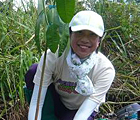
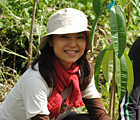
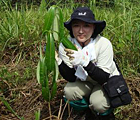
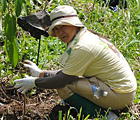
We planted the trees at intervals of eight meters. It was exhausting work just moving through the jungle to the next planting spot. There were still pockets of abundant flora and fauna in the surrounding area. The indigenous but endangered Borneo Elephant uses the ITOCHU forest as a refuge.
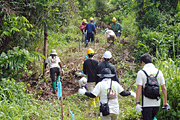
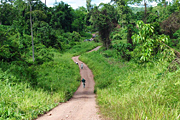
Eventually, 11 people planted close to 200 trees, which brought smiles to everyone’s faces.
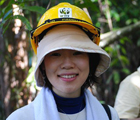
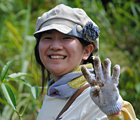
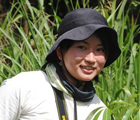

While we were working, we received news that orangutans had been seen in the protected forest. We left the tree-planting site filled with the hope that someday in the near future orangutans would also populate the forest area we had planted.
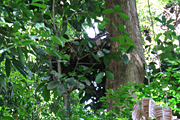
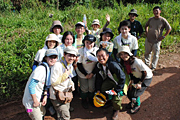
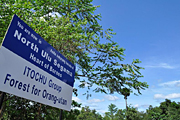
Handy Information 3
Orangutans use leaves to make new beds for themselves in the trees every day. However, sometimes they get lazy and use existing beds.
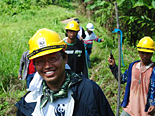
Operations Office, WWF Japan
“Heartfelt Thanks to All of You!”
This latest tour held two especially moving experiences for me. The first was confirming with my own eyes that many of the trees we planted last year have since grown to more than 2 meters in height. The growth of these trees brought home for me the fact that the restoration of the forest has finally begun. The second experience was watching every volunteer show such passion for planting new trees despite the sweltering heat. I was touched by the beauty of seeing people tackle the challenge of trying to restore a forest, as well as the strength of resolve it demands. For me, the tour reaffirmed that the compassion and actions of individuals will one day make the area an abundant forest again. This ITOCHU program is spearheading activities to restore the globally important forests of Borneo. We thank ITOCHU for its continued participation.
Pictures of Some of the Animals on Borneo We Encountered on this Tour
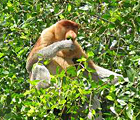
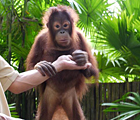
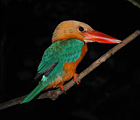
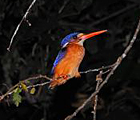
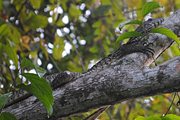
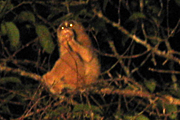
Handy Information 4
The proboscis monkeys and slow loris seen in these photos of the Kinabatangan River basin have fallen in number so dramatically that they have been placed on the IUCN Red List of Threatened Species. We were therefore extremely fortunate indeed to see them in the wild.





